Hemarthria compressa—Aspergillus niger—Trichoderma pseudokoningii Mediated Trilateral Perspective for Bioremediation and Detoxification of Industrial Paper Sludge
Abstract
:1. Introduction
2. Materials and Methods
2.1. Sampling of Sludge
2.2. Collection of Hydrophytes
2.3. Establishment of Nurseries
2.4. Isolation of Fungal Strains
2.5. Experimental Setup and Design
2.6. Physico-Chemical Analyses of Paper Sludge
2.7. Post Harvest Growth and Physico-Chemical Analyses of Plants
2.8. Elemental Quantification
2.9. Antioxidants
2.9.1. Superoxide Dismutase (SOD)
2.9.2. Catalase (CAT)
2.9.3. Peroxidase (POD)
2.9.4. Malondialdehyde (MDA)
2.10. Translocation Factor (TF), Enrichment Coefficient (EC), and Biological Concentration Factor (BCF)
2.11. Statistical Analyses
3. Results
3.1. Physico-Chemical Analysis of Paper Sludge
3.2. Shoot Length
3.3. Number of Roots
3.4. Fresh and Dry Weight
3.5. Total Chlorophyll Contents (SPAD Value)
3.6. Root and Shoot Cadmium
3.7. Root and Shoot Copper
3.8. Root and Shoot Lead
3.9. Root and Shoot Magnesium
3.10. Root and Shoot Sodium
3.11. Calcium and Potassium in Root and Shoot
3.12. Translocation Factor (TF), Enrichment Coefficient (EC), and Biological Concentration Factor (BCF)
3.13. Enzymatic Antioxidants and Malondialdehyde (MDA)
3.14. Pearson Correlation and Principal Component Analysis
4. Discussion
5. Conclusions
Author Contributions
Funding
Institutional Review Board Statement
Informed Consent Statement
Data Availability Statement
Acknowledgments
Conflicts of Interest
References
- Aqeel, M.; Khalid, N.; Tufail, A.; Ahmad, R.Z.; Akhter, M.S.; Luqman, M.; Javed, M.T.; Irshad, M.K.; Alamri, S.; Hashem, M.; et al. Elucidating the distinct interactive impact of cadmium and nickel on growth, photosynthesis, metal-homeostasis, and yield responses of mung bean (Vigna radiata L.) varieties. Environ. Sci. Pollut. Res. 2021, 28, 27376–27390. [Google Scholar] [CrossRef]
- Khalid, N.; Rizvi, Z.F.; Yousaf, N.; Khan, S.M.; Noman, A.; Aqeel, M.; Latif, K.; Rafique, A. Rising Metals Concentration in the Environment: A Response to Effluents of Leather Industries in Sialkot. Bull. Environ. Contam. Toxicol. 2021, 106, 493–500. [Google Scholar] [CrossRef]
- Ali, H.; Khan, E.; Ilahi, I. Environmental chemistry and ecotoxicology of hazardous heavy metals: Environmental persistence, toxicity, and bioaccumulation. J. Chem. 2019, 2019, 6730305. [Google Scholar] [CrossRef] [Green Version]
- Seleiman, M.F.; Santanen, A.; Mäkelä, P.S. Recycling sludge on cropland as fertilizer–Advantages and risks. Resour. Conserv. Recy. 2020, 155, 104647. [Google Scholar] [CrossRef]
- Titilawo, Y.; Adeniji, A.; Adeniyi, M.; Okoh, A. Determination of levels of some metal contaminants in the freshwater environments of Osun State, Southwest Nigeria: A risk assessment approach to predict health threat. Chemosphere 2018, 211, 834–843. [Google Scholar] [CrossRef] [PubMed]
- Yi, Y.; Tang, C.; Yi, T.; Yang, Z.; Zhang, S. Health risk assessment of heavy metals in fish and accumulation patterns in food web in the upper Yangtze River, China. Ecotoxicol. Environ. Saf. 2017, 145, 295–302. [Google Scholar] [CrossRef]
- Shahid, M.J.; Ali, S.; Shabir, G.; Siddique, M.; Rizwan, M.; Seleiman, M.F.; Afzal, M. Comparing the performance of four macrophytes in bacterial assisted floating treatment wetlands for the removal of trace metals (Fe, Mn, Ni, Pb, and Cr) from polluted river water. Chemosphere 2020, 243, 125353. [Google Scholar] [CrossRef] [PubMed]
- Madan, S.; Sachan, P.; Singh, U. A review on bioremediation of pulp and paper mill effluent –An alternative to conventional remedial technologies. J. Appl. Nat. Sci. 2018, 10, 367–374. [Google Scholar] [CrossRef] [Green Version]
- Noman, A.; Hameed, M.; Ali, Q.; Aqeel, M. Foliar tissue architectural diversity among three species of genus Hibiscus for better adaptability under industrial environment. Int. J. Environ. Sci. 2012, 2, 2212–2222. [Google Scholar]
- Khalid, N.; Noman, A.; Aqeel, M.; Masood, A.; Tufail, A. Phytoremediation potential of Xanthium strumarium for heavy metals contaminated soils at roadsides. Int. J. Environ. Sci. Technol. 2019, 16, 2091–2100. [Google Scholar] [CrossRef]
- Tytła, M.; Widziewicz, K.; Zielewicz, E. Heavy metals and its chemical speciation in sewage sludge at different stages of processing. Environ. Technol. 2016, 37, 899–908. [Google Scholar] [CrossRef] [PubMed]
- Singh, R.P.; Agrawal, M. Potential benefits and risks of land application of sewage sludge. Waste Manag. 2008, 28, 347–358. [Google Scholar] [CrossRef] [PubMed]
- Ozcan, S.; Tor, A.; Aydin, M.E. Investigation on the levels of heavy metals, polycyclic aromatic hydrocarbons, and polychlorinated biphenyls in sewage sludge samples and ecotoxicological testing. Clean—Soil Air Water 2013, 41, 411–418. [Google Scholar] [CrossRef]
- Seleiman, M.F.; Santanen, A.; Stoddard, F.L.; Mäkelä, P. Feedstock quality and growth of bioenergy crops fertilized with sewage sludge. Chemosphere 2012, 89, 1211–1217. [Google Scholar] [CrossRef]
- Ghattas, A.-K.; Fischer, F.; Wick, A.; Ternes, T.A. Anaerobic biodegradation of (emerging) organic contaminants in the aquatic environment. Water Res. 2017, 116, 268–295. [Google Scholar] [CrossRef] [PubMed]
- Ojuederie, O.B.; Babalola, O.O. Microbial and plant-assisted bioremediation of heavy metal polluted environments: A review. Int. J. Environ. Res. Public Health 2017, 14, 1504. [Google Scholar] [CrossRef] [Green Version]
- Dixit, R.; Malaviya, D.; Pandiyan, K.; Singh, U.B.; Sahu, A.; Shukla, R.; Singh, B.P.; Rai, J.P.; Sharma, P.K.; Lade, H. Bioremediation of heavy metals from soil and aquatic environment: An overview of principles and criteria of fundamental processes. Sustainability 2015, 7, 2189–2212. [Google Scholar] [CrossRef] [Green Version]
- Kumar, A.; Sharma, B. Consequences of Heavy Metals Pollution in the Environment and Their Bioremediation Practices. In Recent Advances in Environmental Management; CRC Press: Boca Raton, FL, USA, 2018; pp. 253–279. [Google Scholar]
- Yan, A.; Wang, Y.; Tan, S.N.; Mohd Yusof, M.L.; Ghosh, S.; Chen, Z. Phytoremediation: A promising approach for revegetation of heavy metal-polluted land. Front. Plant Sci. 2020, 11, 359. [Google Scholar] [CrossRef]
- Senneca, O.; Cerciello, F.; Russo, C.; Wütscher, A.; Muhler, M.; Apicella, B. Thermal treatment of lignin, cellulose and hemicellulose in nitrogen and carbon dioxide. Fuel 2020, 271, 117656. [Google Scholar] [CrossRef]
- Sun, S.; Zhu, J.; Zheng, Z.; Li, J.; Gan, M. Biosynthesis of β-cyclodextrin modified Schwertmannite and the application in heavy metals adsorption. Powder Technol. 2019, 342, 181–192. [Google Scholar] [CrossRef]
- Gomes, H.I. Phytoremediation for bioenergy: Challenges and opportunities. Environ. Technol. Rev. 2012, 1, 59–66. [Google Scholar] [CrossRef]
- Liu, W.T.; Ni, J.C.; Zhou, Q.X. Uptake of heavy metals by trees: Prospects for phytoremediation. Mater. Sci. Forum 2013, 743, 768–781. [Google Scholar] [CrossRef]
- Lin, H.; Zhang, X.-H.; Chen, J.; Liang, L.; Liu, L.-H. Phytoremediation potential of Leersia hexandra Swartz of copper contaminated soil and its enhancement by using agronomic management practices. Ecol. Eng. 2019, 127, 561–566. [Google Scholar] [CrossRef]
- Sampanpanish, P.; Khaodhiar, S.; Pongsapich, W.; Khan, E. Alternative for chromium removal: Phytoremediation and biosorption with weed plant species in Thailand. Sci. Asia 2007, 33, 353–362. [Google Scholar] [CrossRef]
- Sampanpanish, P.; Pongsapich, W.; Khaodhiar, S.; Khan, E. Chromium removal from soil by phytoremediation with weed plant species in Thailand. Water Air Soil Pollut. Focus 2006, 6, 191–206. [Google Scholar] [CrossRef]
- Bareen, F.; Khilji, S. Bioaccumulation of metals from tannery sludge by Typha angustifolia L. Af. J. Biotechnol. 2008, 7, 3314–3320. [Google Scholar]
- Akhter, N.; Aqeel, M.; Hameed, M.; Alhaithloul, H.A.S.; Alghanem, S.M.; Shahnaz, M.M.; Hashem, M.; Alamri, S.; Khalid, N.; Al-Zoubi, O.M. Foliar architecture and physio-biochemical plasticity determines survival of Typha domingensis pers. Ecotypes in nickel and salt affected soil. Environ. Pollut. 2021, 286, 117316. [Google Scholar] [CrossRef]
- Kalve, S.; Sarangi, B.K.; Pandey, R.A.; Chakrabarti, T. Arsenic and chromium hyperaccumulation by an ecotype of Pteris vittata–prospective for phytoextraction from contaminated water and soil. Curr. Sci. 2011, 100, 888–894. [Google Scholar]
- Redondo-Gómez, S.; Petenello, M.C.; Feldman, S.R. Growth, nutrient status, and photosynthetic response to diesel-contaminated soil of a cordgrass, Spartina argentinensis. Mar. Pollut. Bull. 2014, 79, 34–38. [Google Scholar] [CrossRef]
- Yang, C.; Zhang, X. Hemarhria compressa: Growth behavior and multipurpose. Acta Pratculturae Sin. 2006, 15, 246–248. [Google Scholar]
- Huang, L.; Zhang, X.; Cheng, L.; Chen, L. Evaluation on the Waterlogging Resistance of Whipgrass Germplasm by Subordinate Function. Adv. Sci. Lett. 2012, 7, 328–331. [Google Scholar] [CrossRef]
- Bareen, F.-e.; Nazir, A. Metal decontamination of tannery solid waste using Tagetes patula in association with saprobic and mycorrhizal fungi. Environmentalist 2010, 30, 45–53. [Google Scholar] [CrossRef]
- Greenburg, A.; Clesceri, L.; Eaton, A. Standard Methods for the Examination of Water and Wastewater, 20th ed.; American Public Health Association: Washington, DC, USA, 1998. [Google Scholar]
- Wolf, B. A comprehensive system of leaf analyses and its use for diagnosing crop nutrient status. Commun. Soil Sci. Plant Anal. 1982, 13, 1035–1059. [Google Scholar] [CrossRef]
- Giannopolitis, C.N.; Ries, S.K. Superoxide dismutases: II. Purification and quantitative relationship with water-soluble protein in seedlings. Plant Physiol. 1977, 59, 315–318. [Google Scholar] [CrossRef] [Green Version]
- Chance, B.; Maehly, A. Assay of catalases and peroxidases. Methods Enzymol. 1955, 2, 764–775. [Google Scholar] [CrossRef]
- Cakmak, I.; Horst, W.J. Effect of aluminium on lipid peroxidation, superoxide dismutase, catalase, and peroxidase activities in root tips of soybean (Glycine max). Physiol. Plant. 1991, 83, 463–468. [Google Scholar] [CrossRef]
- Gonzaga, M.I.S.; Santos, J.A.G.; Ma, L.Q. Arsenic phytoextraction and hyperaccumulation by fern species. Sci. Agric. 2006, 63, 90–101. [Google Scholar] [CrossRef]
- Zhao, F.; Lombi, E.; McGrath, S. Assessing the potential for zinc and cadmium phytoremediation with the hyperaccumulator Thlaspi caerulescens. Plant Soil 2003, 249, 37–43. [Google Scholar] [CrossRef]
- Coakley, S.; Cahill, G.; Enright, A.-M.; O’Rourke, B.; Petti, C. Cadmium hyperaccumulation and translocation in Impatiens glandulifera: From foe to friend? Sustainability 2019, 11, 5018. [Google Scholar] [CrossRef] [Green Version]
- Kim, H.-Y. Analysis of variance (ANOVA) comparing means of more than two groups. Restor. Dent. Endod. 2014, 39, 74. [Google Scholar] [CrossRef] [Green Version]
- Steel, R.G.; Torrie, J.H.; Dickey, D.A. Principles and Procedures of Statistics; McGraw-Hill: New York, NY, USA, 1997; pp. 4–7. [Google Scholar]
- R Development Core Team. R: A Language and Environment for Statistical Computing; R Foundation for Statistical Computing: Vienna, Austria, 2018; Available online: http://www.R-project.org (accessed on 15 March 2021).
- Liu, J.; Kummerow, C.D.; Elsaesser, G.S. Identifying and analysing uncertainty structures in the TRMM microwave imager precipitation product over tropical ocean basins. Int. J. Remote Sens. 2017, 38, 23–42. [Google Scholar] [CrossRef]
- Wasay, S.A.; Barrington, S.F.; Tokunaga, S. Using Aspergillus niger to bioremediate soils contaminated by heavy metals. Bioremed. J. 1998, 2, 183–190. [Google Scholar] [CrossRef]
- Hewedy, O.A.; Abdel Lateif, K.S.; Seleiman, M.F.; Shami, A.; Albarakaty, F.M.; M El-Meihy, R. Phylogenetic diversity of Trichoderma strains and their antagonistic potential against soil-borne pathogens under stress conditions. Biology 2020, 9, 189. [Google Scholar] [CrossRef]
- Mazurek, R.; Kowalska, J.; Gąsiorek, M.; Setlak, M. Micromorphological and physico-chemical analyses of cultural layers in the urban soil of a medieval city—A case study from Krakow, Poland. Catena 2016, 141, 73–84. [Google Scholar] [CrossRef]
- Torkashv, A.M.; Haghighat, N.; Shadparvar, V. Effect of paper mill lime sludge as an acid soil amendment. Sci. Res. Essays. 2010, 5, 1302–1306. [Google Scholar]
- Khaliq, S.J.A.; Al-Busaidi, A.; Ahmed, M.; Al-Wardy, M.; Agrama, H.; Choudri, B.S. The effect of municipal sewage sludge on the quality of soil and crops. Int. J. Recycl. Org. Waste Agric. 2017, 6, 289–299. [Google Scholar] [CrossRef] [Green Version]
- Akhter, N.; Aqeel, M.; Shahnaz, M.M.; Alnusairi, G.S.; Alghanem, S.M.; Kousar, A.; Hashem, M.; Kanwal, H.; Alamri, S.; Ilyas, A. Physiological homeostasis for ecological success of Typha (Typha domingensis Pers.) populations in saline soils. Physiol. Mol. Biol. Plants 2021, 27, 687–701. [Google Scholar] [CrossRef] [PubMed]
- Khalid, N.; Hussain, M.; Young, H.S.; Boyce, B.; Aqeel, M.; Noman, A. Effects of road proximity on heavy metal concentrations in soils and common roadside plants in Southern California. Environ. Sci. Pollut. Res. 2018, 25, 35257–35265. [Google Scholar] [CrossRef] [PubMed]
- Noman, A.; Aqeel, M.; Javed, M.; Zafar, S.; Ali, Q.; Islam, W.; Irshad, M.; Buriro, M.; Kanwal, H.; Khalid, N. Histological changes in Hibiscus rosa-sinensis endorse acclimation and phytoremediation of industrially polluted sites. J. Anim. Plant Sci. 2017, 27, 1637–1648. [Google Scholar]
- Qasim, M.; Lin, Y.; Dash, C.K.; Bamisile, B.S.; Ravindran, K.; Islam, S.U.; Ali, H.; Wang, F.; Wang, L. Temperature-dependent development of Asian citrus psyllid on various hosts, and mortality by two strains of Isaria. Microb. Pathog. 2018, 119, 109–118. [Google Scholar] [CrossRef] [PubMed]
- Qasim, M.; Xiao, H.; He, K.; Omar, M.A.; Hussain, D.; Noman, A.; Rizwan, M.; Khan, K.A.; Al-Zoubi, O.M.; Alharbi, S.A. Host-pathogen interaction between Asian citrus psyllid and entomopathogenic fungus (Cordyceps fumosorosea) is regulated by modulations in gene expression, enzymatic activity and HLB-bacterial population of the host. Comp. Biochem. Physiol. C Toxicol. Pharmacol. 2021, 248, 109112. [Google Scholar] [CrossRef] [PubMed]
- Ge, W.; Zamri, D.; Mineyama, H.; Valix, M. Bioaccumulation of heavy metals on adapted Aspergillus foetidus. Adsorption 2011, 17, 901. [Google Scholar] [CrossRef]
- Irshad, M.K.; Noman, A.; Wang, Y.; Yin, Y.; Chen, C.; Shang, J. Goethite modified biochar simultaneously mitigates the arsenic and cadmium accumulation in paddy rice (Oryza sativa) L. Environ. Res. 2021, 112238. [Google Scholar] [CrossRef]
- Medfu-Tarekegn, M.; Zewdu Salilih, F.; Ishetu, A.I. Microbes used as a tool for bioremediation of heavy metal from the environment. Cogent Food Agric. 2020, 6, 1783174. [Google Scholar] [CrossRef]
- Lin, J.; Kroll, C.N.; Nowak, D.J.; Greenfield, E.J. A review of urban forest modeling: Implications for management and future research. Urban For. Urban Green. 2019, 43, 126366. [Google Scholar] [CrossRef]
- Seneviratne, M.; Seneviratne, G.; Madawala, H.; Vithanage, M. Role of rhizospheric microbes in heavy metal uptake by plants. In Agro-Environmental Sustainability; Springer: Cham, Switzerland, 2017; pp. 147–163. [Google Scholar]
- Gube, M. 4 Fungal molecular response to heavy metal stress. In Biochemistry and Molecular Biology; Springer: Cham, Switzerland, 2016; pp. 47–68. [Google Scholar]
- Ullah, A.; Heng, S.; Munis, M.F.H.; Fahad, S.; Yang, X. Phytoremediation of heavy metals assisted by plant growth promoting (PGP) bacteria: A review. Environ. Exp. Bot. 2015, 117, 28–40. [Google Scholar] [CrossRef]
- Houri, T.; Khairallah, Y.; Al Zahab, A.; Osta, B.; Romanos, D.; Haddad, G. Heavy metals accumulation effects on the photosynthetic performance of geophytes in Mediterranean reserve. J. King Saud Univ. Sci. 2020, 32, 874–880. [Google Scholar] [CrossRef]
- Fomina, M.; Hillier, S.; Charnock, J.; Melville, K.; Alexander, I.J.; Gadd, G. Role of oxalic acid overexcretion in transformations of toxic metal minerals by Beauveria caledonica. Appl. Environ. Microbiol. 2005, 71, 371–381. [Google Scholar] [CrossRef] [PubMed] [Green Version]
- Gadd, G.M.; Bahri-Esfahani, J.; Li, Q.; Rhee, Y.J.; Wei, Z.; Fomina, M.; Liang, X. Oxalate production by fungi: Significance in geomycology, biodeterioration and bioremediation. Fungal Biol. Rev. 2014, 28, 36–55. [Google Scholar] [CrossRef]
- Tiwari, S.; Dixit, S.; Verma, N. An effective means of biofiltration of heavy metal contaminated water bodies using aquatic weed Eichhornia crassipes. Environ. Monit. Assess. 2007, 129, 253–256. [Google Scholar] [CrossRef]
- Liao, S.-W.; Chang, W.-L. Heavy metal phytoremediation by water hyacinth at constructed wetlands in Taiwan. J. Aquat. Plant Manag. 2004, 42, 60–68. [Google Scholar]
- Zeng, F.; Mao, Y.; Cheng, W.; Wu, F.; Zhang, G. Genotypic and environmental variation in chromium, cadmium and lead concentrations in rice. Environ. Pollut. 2008, 153, 309–314. [Google Scholar] [CrossRef] [PubMed]
- Mishra, V.K.; Tripathi, B. Accumulation of chromium and zinc from aqueous solutions using water hyacinth (Eichhornia crassipes). J. Hazard. Mater. 2009, 164, 1059–1063. [Google Scholar] [CrossRef]
- Hossain, M.B.; Rakib, M.R.J.; Jolly, Y.; Rahman, M. Metals uptake and translocation in salt marsh macrophytes, Porteresia sp. from Bangladesh coastal area. Sci. Total Environ. 2021, 764, 144637. [Google Scholar] [CrossRef]
- Mahardika, G.; Rinanti, A.; Fachrul, M. Phytoremediation of heavy metal copper (Cu2+) by sunflower (Helianthus annuus L.). IOP Conf. Ser. Earth Environ. Sci. 2018, 106, 012120. [Google Scholar] [CrossRef]
- Fei, Y.-h.; Zhao, D.; Liu, Y.; Zhang, W.; Tang, Y.-Y.; Huang, X.; Wu, Q.; Wang, Y.-X.; Xiao, T.; Liu, C. Feasibility of sewage sludge derived hydrochars for agricultural application: Nutrients (N, P, K) and potentially toxic elements (Zn, Cu, Pb, Ni, Cd). Chemosphere 2019, 236, 124841. [Google Scholar] [CrossRef]
- Selivanovskaya, S.Y.; Latypova, V. Effects of composted sewage sludge on microbial biomass, activity and pine seedlings in nursery forest. Waste Manag. 2006, 26, 1253–1258. [Google Scholar] [CrossRef] [PubMed]
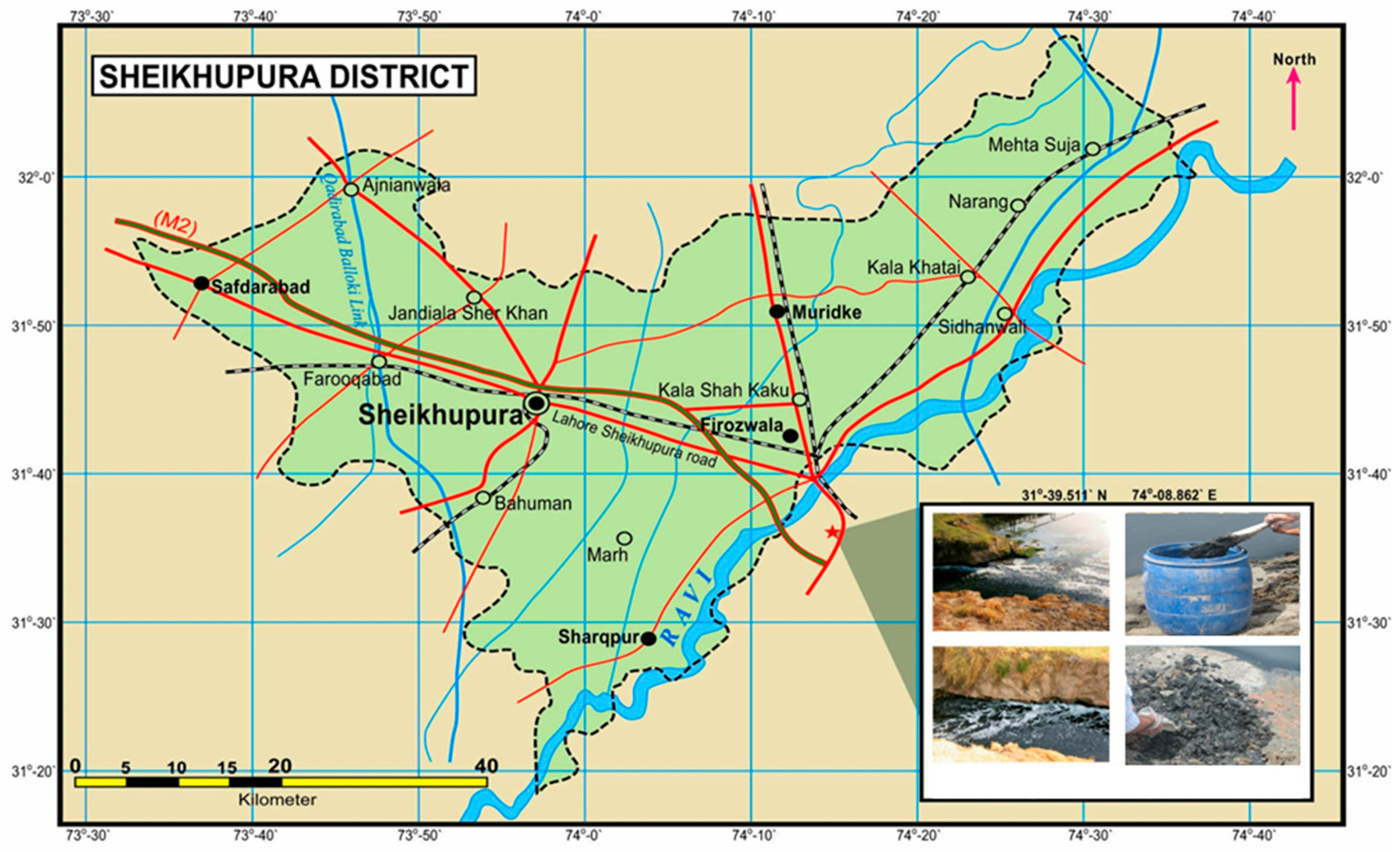
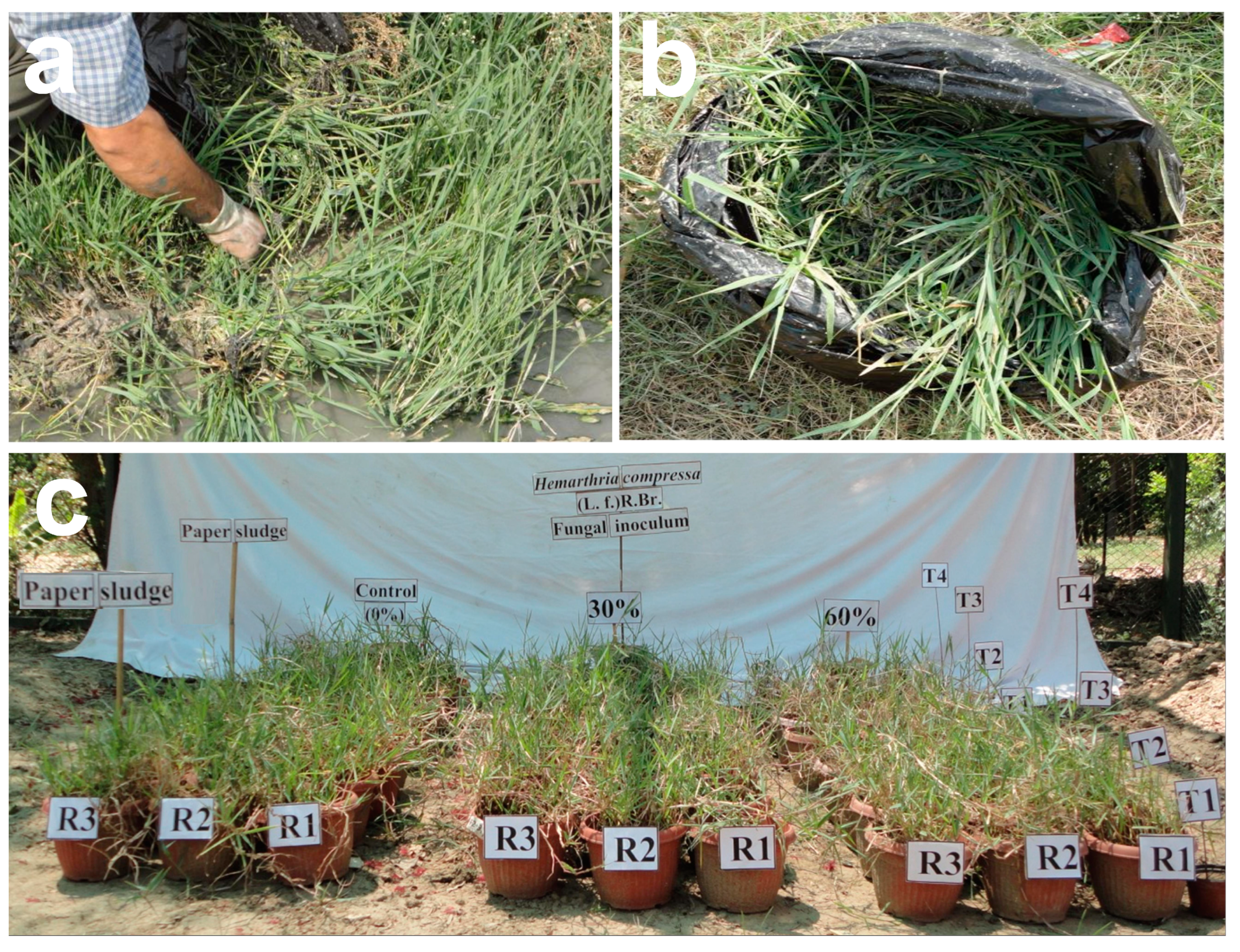
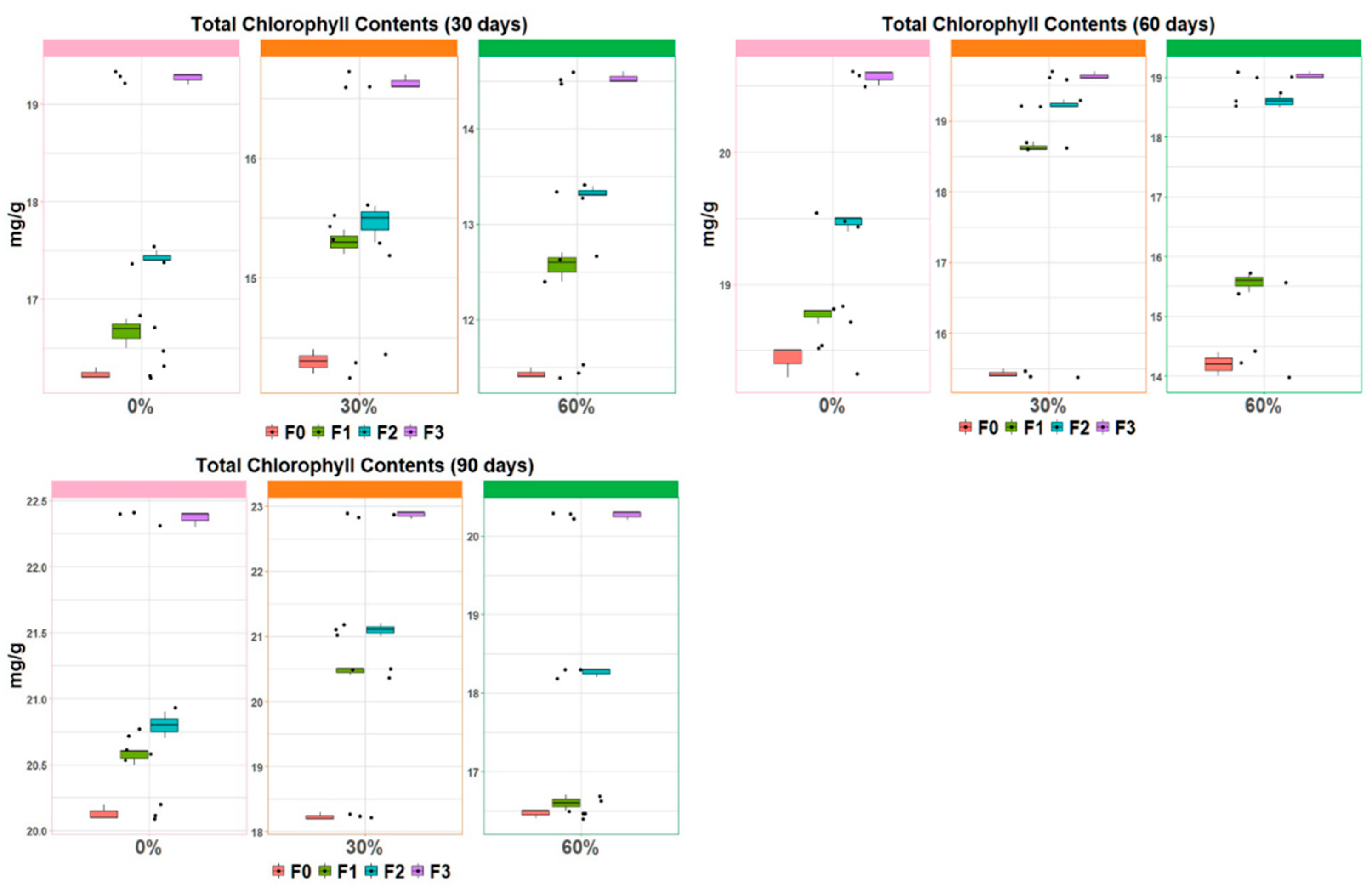
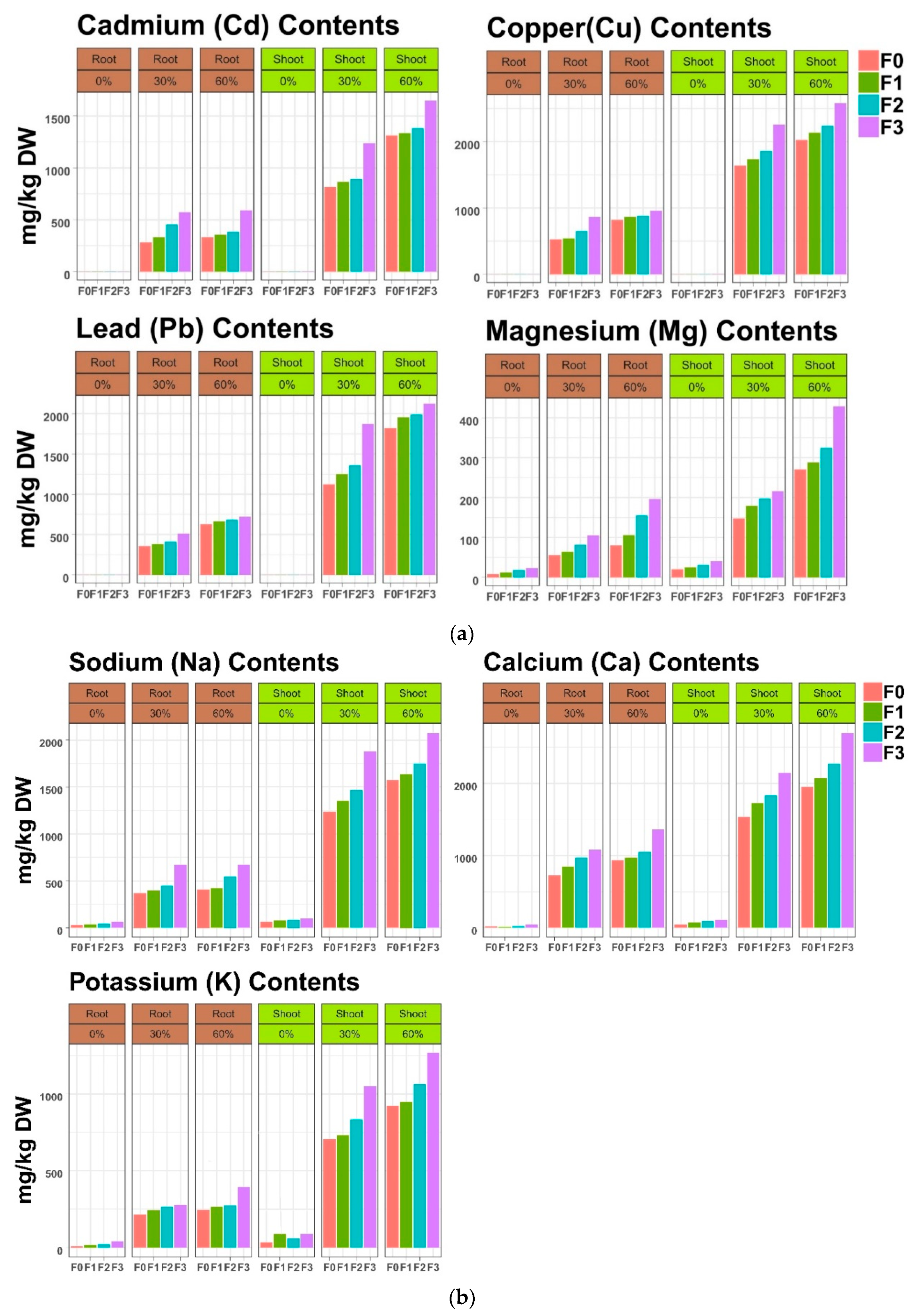
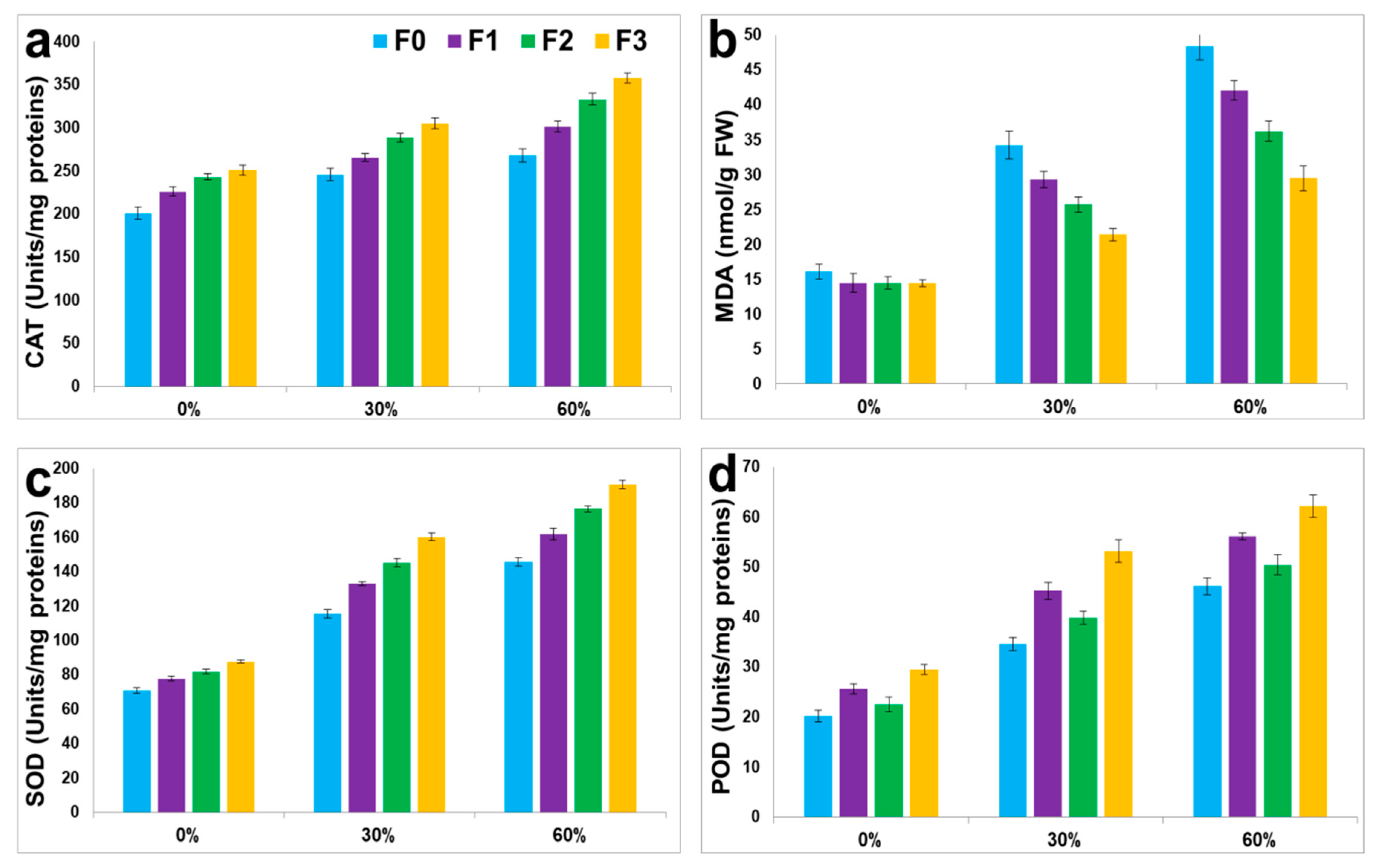


| Sludge Concentrations | Treatments | |||
|---|---|---|---|---|
| F0 | F1 | F2 | F3 | |
| 0% | R1 | R1 | R1 | R1 |
| R2 | R2 | R2 | R2 | |
| R3 | R3 | R3 | R3 | |
| 30% | R1 | R1 | R1 | R1 |
| R2 | R2 | R2 | R2 | |
| R3 | R3 | R3 | R3 | |
| 60% | R1 | R1 | R1 | R1 |
| R2 | R2 | R2 | R2 | |
| R3 | R3 | R3 | R3 | |
| Parameters | 0% (TW Only) | 30% (TW + PS) | 60% (TW + PS) | 100% (PS Only) |
|---|---|---|---|---|
| pH | 7.29 ± 0.06 d | 8.20 ± 0.02 c | 8.71 ± 0.06 b | 8.87 ± 0.04 a |
| Conductivity (mS/cm) | 0.295 ± 0.01 d | 5.34 ± 0.05 c | 5.11 ± 2.6 b | 5.45 ± 0.06 a |
| Chlorides (mg/L) | 30 ± 0.43 d | 256 ± 0.36 c | 371 ± 0.64 b | 423 ± 0.75 a |
| BOD (mg/L) | 110 ± 0.26 c | 150 ± 0.04 bc | 190 ± 0.11 b | 250 ± 0.03 a |
| COD (mg/L) | 200 ± 0.06 d | 1200 ± 0.12 c | 1700 ± 0.07 b | 1600 ± 0.05 a |
| Ca (mg/L) | 80 ± 0.17 d | 1852 ± 1.53 c | 2059 ± 1.68 b | 2344 ± 1.77 a |
| K (mg/L) | 12 ± 0.1 d | 935 ± 0.68 c | 1050 ± 1.10 b | 1322 ± 2.33 a |
| Na (mg/L) | 145 ± 0.36 d | 1210 ± 0.45 c | 1522 ± 0.30 b | 1820 ± 0.42 a |
| Mg (mg/L) | 20 ± 0.16 d | 80 ± 0.33 c | 104 ± 0.40 b | 156 ± 0.02 a |
| Cd (mg/L) | ND | 934 ± 0.24 c | 1143 ± 0.53 b | 1422 ± 0.23 a |
| Cu (mg/L) | ND | 2168 ± 1.53 c | 2529 ± 1.15 b | 2933 ± 2.12 a |
| Pb (mg/L) | ND | 1026 ± 0.40 c | 1887 ± 1.10 b | 2213 ± 0.21 a |
| Organic matter (%) | ND | 23.10 ± 0.10 c | 37.14 ± 0.03 bc | 42.23 ± 0.07 a |
| Parameter | Conc. of PS | Treatments of Fungal Strains | |||
|---|---|---|---|---|---|
| F0 | F1 | F2 | F3 | ||
| Shoot length (cm) | 0% | 9.3 ± 0.01 aC | 11.2 ± 0.09 aA | 10.8 ± 0.06 aB | 8.7 ± 0.03 aDE |
| 30% | 8.3 ± 0.07 bC | 8.8 ± 0.03 cC | 10.2 ± 0.03 abA | 7.2 ± 0.37 bD | |
| 60% | 8.5 ± 0.07 bB | 9.1 ± 0.01 bA | 8.2 ± 0.03 bB | 6.3 ± 0.07 cD | |
| No. of roots | 0% | 10 ± 0.02 aB | 6 ± 0.04 bD | 8 ± 0.05 bC | 12 ±0.03 aA |
| 30% | 7 ± 0.04 bB | 6 ± 0.04 bC | 7 ± 0.03 cB | 9 ± 0.01 bA | |
| 60% | 5 ± 0.04 cD | 7 ± 0.02 aC | 9 ± 0.01 aB | 11 ± 0.04 aA | |
| Fresh weight (g) | 0% | 2.70 ± 0.01 aC | 3.03 ± 0.04 aB | 3.06 ± 0.03 aB | 3.12 ± 0.06 aA |
| 30% | 2.0 ± 0.03 bC | 2.02 ± 0.01 bB | 2.06 ± 0.05 bB | 3.0 ± 0.07 abA | |
| 60% | 1.8 ± 0.05 cC | 1.7 ± 0.06 cC | 1.10 ± 0.01 cAB | 1.12 ± 0.02 cAB | |
| Dry weight (g) | 0% | 1.92 ± 0.01 aCD | 1.85 ± 0.03 aCD | 2.58 ± 0.02 aB | 2.74 ± 0.09 aA |
| 30% | 1.62 ± 0.05 bC | 1.43 ± 0.06 bD | 1.48 ± 0.04 bD | 1.54 ± 0.07 bE | |
| 60% | 1.35 ± 0.08 cC | 1.23 ± 0.05 cD | 1.37 ± 0.07 bcB | 1.45 ± 0.06 bcA | |
| Ions | PS Concentration | Translocation Factor (TF) | Enrichment Coefficient (EC) | Bio-Concentration Factor (BCF) | |||||||||
|---|---|---|---|---|---|---|---|---|---|---|---|---|---|
| F0 | F1 | F2 | F3 | F0 | F1 | F2 | F3 | F0 | F1 | F2 | F3 | ||
| Ca | 0% | 2.44 | 3.33 | 3.66 | 2.32 | 0.55 | 0.87 | 1.11 | 1.33 | 0.77 | 1.06 | 1.40 | 1.91 |
| 30% | 2.07 | 2.03 | 1.88 | 1.98 | 0.81 | 0.93 | 0.99 | 1.16 | 1.20 | 1.38 | 1.51 | 1.74 | |
| 60% | 2.09 | 2.11 | 2.15 | 1.95 | 0.94 | 1.00 | 1.10 | 1.30 | 1.40 | 1.47 | 1.61 | 1.97 | |
| K | 0% | 3.5 | 2.5 | 2.60 | 2.2 | 2.91 | 3.75 | 5.00 | 7.33 | 3.75 | 5.25 | 6.91 | 10.66 |
| 30% | 3.25 | 3.09 | 3.16 | 3.77 | 0.75 | 0.77 | 0.89 | 1.11 | 0.98 | 1.01 | 1.18 | 1.41 | |
| 60% | 3.71 | 3.57 | 3.83 | 3.20 | 0.86 | 0.9 | 1.01 | 1.20 | 1.1 | 1.15 | 1.27 | 1.58 | |
| Na | 0% | 1.5 | 1.60 | 1.54 | 1.49 | 0.43 | 0.53 | 0.58 | 0.68 | 0.65 | 0.80 | 0.90 | 1.15 |
| 30% | 3.24 | 3.46 | 3.26 | 2.80 | 1.01 | 1.11 | 1.21 | 1.55 | 1.32 | 1.43 | 1.58 | 2.10 | |
| 60% | 3.87 | 3.87 | 3.23 | 3.09 | 1.04 | 1.07 | 1.15 | 1.36 | 1.31 | 1.35 | 1.50 | 1.80 | |
| Mg | 0% | 1.42 | 1.52 | 1.60 | 1.42 | 1.5 | 1.9 | 2.25 | 2.5 | 1.4 | 1.8 | 2.4 | 3.1 |
| 30% | 2.67 | 2.80 | 2.47 | 2.00 | 1.87 | 2.23 | 2.47 | 2.63 | 2.575 | 3.037 | 3.475 | 3.95 | |
| 60% | 3.41 | 2.70 | 2.08 | 2.18 | 2.62 | 2.75 | 3.12 | 4.16 | 3.39 | 3.77 | 4.62 | 6.06 | |
| Cd | 0% | 3.33 | 3.5 | 3.29 | 3.03 | 0 | 0 | 0 | 0 | 0 | 0 | 0 | 0 |
| 30% | 2.83 | 2.67 | 1.97 | 2.14 | 0.85 | 0.92 | 0.95 | 1.30 | 1.15 | 1.27 | 1.43 | 1.91 | |
| 60% | 3.92 | 3.79 | 3.66 | 2.87 | 1.14 | 1.16 | 1.20 | 1.43 | 1.44 | 1.46 | 1.53 | 1.94 | |
| Cu | 0% | 3.25 | 3.7 | 1.84 | 1.98 | 0 | 0 | 0 | 0 | 0 | 0 | 0 | 0 |
| 30% | 3.07 | 3.23 | 2.86 | 2.65 | 0.74 | 0.79 | 0.85 | 1.04 | 0.10 | 1.04 | 1.14 | 1.43 | |
| 60% | 2.47 | 2.46 | 2.55 | 2.70 | 0.80 | 0.84 | 0.88 | 1.02 | 1.12 | 1.18 | 1.23 | 1.39 | |
| Pb | 0% | 1.7 | 2.08 | 2.69 | 1.9 | 0 | 0 | 0 | 0 | 0 | 0 | 0 | 0 |
| 30% | 3.07 | 3.33 | 3.31 | 3.66 | 1.09 | 1.21 | 1.31 | 1.82 | 1.45 | 1.58 | 1.71 | 2.31 | |
| 60% | 2.87 | 2.95 | 2.94 | 2.90 | 0.96 | 1.04 | 1.05 | 1.11 | 1.30 | 1.39 | 1.40 | 1.50 | |
Publisher’s Note: MDPI stays neutral with regard to jurisdictional claims in published maps and institutional affiliations. |
© 2021 by the authors. Licensee MDPI, Basel, Switzerland. This article is an open access article distributed under the terms and conditions of the Creative Commons Attribution (CC BY) license (https://creativecommons.org/licenses/by/4.0/).
Share and Cite
Khilji, S.A.; Aqeel, M.; Maqsood, M.F.; Khalid, N.; Tufail, A.; Sajid, Z.A.; Al-Surhanee, A.A.; Hashem, M.; Alamri, S.; Al-Mutairi, K.A.; et al. Hemarthria compressa—Aspergillus niger—Trichoderma pseudokoningii Mediated Trilateral Perspective for Bioremediation and Detoxification of Industrial Paper Sludge. Sustainability 2021, 13, 12266. https://doi.org/10.3390/su132112266
Khilji SA, Aqeel M, Maqsood MF, Khalid N, Tufail A, Sajid ZA, Al-Surhanee AA, Hashem M, Alamri S, Al-Mutairi KA, et al. Hemarthria compressa—Aspergillus niger—Trichoderma pseudokoningii Mediated Trilateral Perspective for Bioremediation and Detoxification of Industrial Paper Sludge. Sustainability. 2021; 13(21):12266. https://doi.org/10.3390/su132112266
Chicago/Turabian StyleKhilji, Sheza Ayaz, Muhammad Aqeel, Muhammad Faisal Maqsood, Noreen Khalid, Aasma Tufail, Zahoor Ahmad Sajid, Ameena A. Al-Surhanee, Mohamed Hashem, Saad Alamri, Khalid Awadh Al-Mutairi, and et al. 2021. "Hemarthria compressa—Aspergillus niger—Trichoderma pseudokoningii Mediated Trilateral Perspective for Bioremediation and Detoxification of Industrial Paper Sludge" Sustainability 13, no. 21: 12266. https://doi.org/10.3390/su132112266
APA StyleKhilji, S. A., Aqeel, M., Maqsood, M. F., Khalid, N., Tufail, A., Sajid, Z. A., Al-Surhanee, A. A., Hashem, M., Alamri, S., Al-Mutairi, K. A., & Noman, A. (2021). Hemarthria compressa—Aspergillus niger—Trichoderma pseudokoningii Mediated Trilateral Perspective for Bioremediation and Detoxification of Industrial Paper Sludge. Sustainability, 13(21), 12266. https://doi.org/10.3390/su132112266







